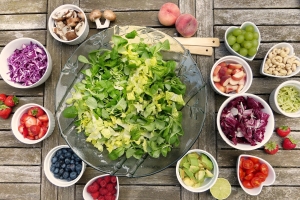What kind of diet is right for you? This is a question that I get asked by almost everyone who finds out what I do for a living, and rightfully so! There is so much confusion around what to eat and how to eat that many people simply don’t make any changes because they don’t know what approach is the right one. I call it analysis paralysis.
Now, more than ever, people are bombarded with diet and health advice everywhere they turn. Instagram and YouTube have become hubs for influencers to promote the latest juice cleanse or skinny tea — but take a step back and think. If it was this easy wouldn’t everyone buy this tea/ gummy/ shake/ vitamin and be healthy? Let this serve as a reminder that you should only seek health advice from qualified and trained professionals who know you and your body. Everyone is different and has different needs, so make sure you are treating your body with the respect it deserves!
Ok, so back to diet. Low carb, low fat, high protein, keto, paleo, whole 30, vegan, vegetarian — which one is right?!
The simple answer — none of them.
You might be thinking, “MY neighbor lost 30 pounds on keto and she is feeling great so I want to do that!” Swap keto with any of the above diets and you likely know what I’m talking about.
Take a look at what they were eating before versus what they are eating now. Many of these styles of eating eliminate processed foods for one reason or another. They eliminate fried foods, foods high in saturated fat content, and add in more whole foods options such as fruits, vegetables, whole grains, nuts and seeds, high-quality fats and oils, and lean proteins. What do all of these foods have in common? They are anti-inflammatory!
Eating an anti-inflammatory diet is the basis of keeping the body in balance regarding inflammation, hormone balance, blood sugar regulation, managing cholesterol, and as a result of all of these things — weight.
When we go from eating a Standard American Diet (SAD) rich in ultra-processed foods to one that eliminates packaged and processed foods we are steering clear of added colors, sugars, and preservatives that wreak havoc on the body and can really do some damage over time. See the last blog post linked here to learn more about specific food additives and their dangers.
Here are my favorite 4 tips for reducing inflammation in your diet:
- Eat the rainbow: Eating a diet rich in colorful fruits and vegetables is key for reducing inflammation and healing the body. I like to challenge my clients to make every meal as colorful as possible. Instead of an all-green salad of just lettuce and cucumbers add tomatoes, red onion, shredded carrot, nuts and seeds, berries, salmon, etc. The more color variety you get in your diet the more phytonutrients you are getting. What are phytonutrients? They are a category of chemicals made by plants that have beneficial effects on the human body. See the chart below for common phytonutrients and their functions within the human body!
| Phytonutrient: | Benefits: | Foods found in: |
| Beta Carotene | The immune system, vision, skin health, bone health | Dark leafy greens such as kale, spinach, collard greens, broccoli, and orange foods such as sweet potato, carrots, pumpkin, squash, cantaloupe, and apricot |
| Lycopene | Promote heart health and are anti-cancer (especially prostate cancer) | Red foods such as tomatoes, grapefruit, red peppers, and watermelon., Heating makes lycopene more absorbable so make sure to get your cooked tomatoes and peppers in as well! |
| Lutein | Promotes healthy eyes, heart health, and prevents cancer | Found in green vegetables such as collard greens, kale, spinach, broccoli, brussels sprouts, lettuces, and artichokes. Lutein can be found in the macula of the eye and an MPOD test can actually look at the levels in your eye! Consult your ophthalmologist for this test. |
| Resveratrol | Anti-inflammatory, anti-cancer. Promotes heart and lung health | Found in peanuts and grapes. Many people drink wine for anti-inflammatory properties from the grapes but keep in mind that alcohol by nature is inflammatory. It is best to consume the food in its most whole state whenever possible. |
| Anthocyanidins | Blood vessel and cardiovascular health | Found in the skins of red and purple colored fruits such as grapes and berries. Found in blueberries, blackberries, raspberries, cranberries, grapes, plums, red onions, red potatoes, radishes, and strawberries. |
| Isoflavones | Hormone balance relating to menopause, breast cancer prevention, healthy bones and joints, cholesterol-lowering, and anti-inflammatory | Rich in soybeans. Always aim to buy organic soy products whenever possible! |
- Know your oils! Olive oil is a good fat — it boasts heart-healthy Omega-3’s which can bring your good cholesterol up and the bad cholesterol down. Unfortunately, it is not that simple. Cooking with olive oil at high heat can actually destroy the beneficial part of the oil, leaving it oxidized and pro-inflammatory rather than anti-inflammatory. Instead, opt for using avocado oil when cooking and save your olive oil for salad dressings or drizzling over a dish once it has been cooked for extra flavor. Always go for color-pressed extra virgin oils and make sure it is in a dark bottle. Store away from heat and light. Don’t be afraid to water saute! Drizzle your oil after.
- Fiber is your friend! The average American consumes only 8 grams of fiber per day. Women should aim for a minimum of 25g and men 30g. What does fiber do that is so great? High fiber foods (fruits and vegetables, whole grains, beans and legumes, nuts and seeds) aid in keeping you full and satisfied, keeping blood sugars stable. Fiber works to balance hormones, feed those good bacteria in the gut, keep the digestive system clean and efficient, and can balance cholesterol levels. Fiber acts as a scrubber as it travels through the GI. It can attach itself to things like fats and toxins and escort them out of the body. Over time this purifies and aids in your body’s natural detox functions. We don’t need a skinny tea or a fancy supplement to do what our body is already designed to do!
Aim for 10g of fiber at each meal or 8-9 per meal and some with snacks. Replacing a processed food snack such as pretzels with a whole food snack such as a cut-up bell pepper and your favorite hummus can make all the difference when reaching your fiber goals. Studies have shown that individuals with high intakes of dietary fiber appear to be at significantly lower risk for developing coronary heart disease, stroke, hypertension, diabetes, obesity, and certain gastrointestinal diseases. Increasing fiber intake lowers blood pressure and serum cholesterol levels.
If you are meeting your fiber goals, likely, you won’t have much room for other foods as fiber-filled foods are typically bulky and hearty (think whole grains, fruits, vegetables). I recommend seeing where you’re at with your fiber consumption and slowly increase a few grams every few days until reaching your goal! Increasing too much too soon can cause digestive issues. Make sure to drink plenty of water as well when adding more fiber to your diet.
- Portion your protein! The average American eats far more protein than their body needs. We do need protein for cell rejuvenation, building muscle and new tissues, essential vitamins and minerals, etc. What we don’t need is a 12oz piece of steak or 8oz of salmon in one sitting. Use a deck of cards as a guide for meat portions. Another great way to see how much your body might need is using the palm of your hand as a guide. The surface area of your palm is a more individualized way to see if your body might need more or less than the standard deck of cards. Try thinking of shifting your focus from meat being the main event of the meal and let the vegetables be the star. Use meat as a garnish and fill your plate with 75% vegetables and the rest whole grains/ beans and protein. You will quickly see how it can be easy to meet your fiber goals while still eating the foods you love regularly.
If you are looking to dive into your nutrition and learn what kind of diet is right for you call us at 201-488-6678 to make an appointment!
References
Anderson, J. W., Baird, P., Davis, R. H., Jr, Ferreri, S., Knudtson, M., Koraym, A., Waters, V., & Williams, C. L. (2009). Health benefits of dietary fiber. Nutrition reviews, 67(4), 188–205. https://doi.org/10.1111/j.1753-4887.2009.00189.x
Linus Pauling Institute. “Macronutrient Information Center,” Oregon State University, Accessed March 19, 2012, from
http://lpi.oregonstate.edu/infocenter/phytochemicals/resveratrol/
Linus Pauling Institute. “Macronutrient Information Center,” Oregon State University, Accessed March 19, 2012, from
http://lpi.oregonstate.edu/infocenter/phytochemicals/soyiso/






